When you think about cycling injuries, you likely picture traumatic “Road Rash” crashes – Not chronic elbow tendon pain, like Tennis Elbow or Golfer’s Elbow!
But the fact is, these kinds of injuries are common among ALL kinds of cyclists, hence terms like “Mountain Bikers Elbow” and “Motocross Elbow.”
So, if you’re a cyclist, and you’re starting to wonder:
“Could this stubborn pain and tension in my elbow (or wrist) from riding be a real injury?”
The answer is, yes, it could very well be a significant injury…
Whether your passion is road cycling, mountain biking, BMX, Motocross – or even spinning on a stationary exercise bike!
And, unfortunately, these ‘overuse injuries’ can sometimes be just as hard – If not harder to recover from – than crash-and-smash injuries.
So, here’s what to look out for, symptom-wise, below…
Then we’ll get into bike fitting tips and “stuff to fix” for different kinds of bikes.
And, finally, we’ll get into the nature of these terrible tendon injuries – The right and wrong way to treat them, and more…
Podcast Episode
Here’s the podcast version, (which contains all the audio from the video.) Play OR download for later – and please subscribe via the links below.
Skip to any section you want with the bookmark links below:
Table Of Contents
(Links jump down the page to various sections of this article.)
- Warning signs – The early warning symptoms
- Mountain Biker’s Elbow – MB Elbow and bike fitting tips
- Road Rider’s Elbow – Cyclist’s Elbow + bike fitting tips for road riders
- Motocross Elbow Pain – Motocross and motorcyclists
- BMX – BMX Related Elbow Pain
- Stationary Biking – Stationary bike riding / spinning elbow pain
- Alignment – Tension, posture / alignment-related factors
- Causes – How cycling causes Tennis / Golfer’s Elbow
- Wrong Way – The wrong way to treat these injuries
- RIGHT Way – The right way to treat these injuries
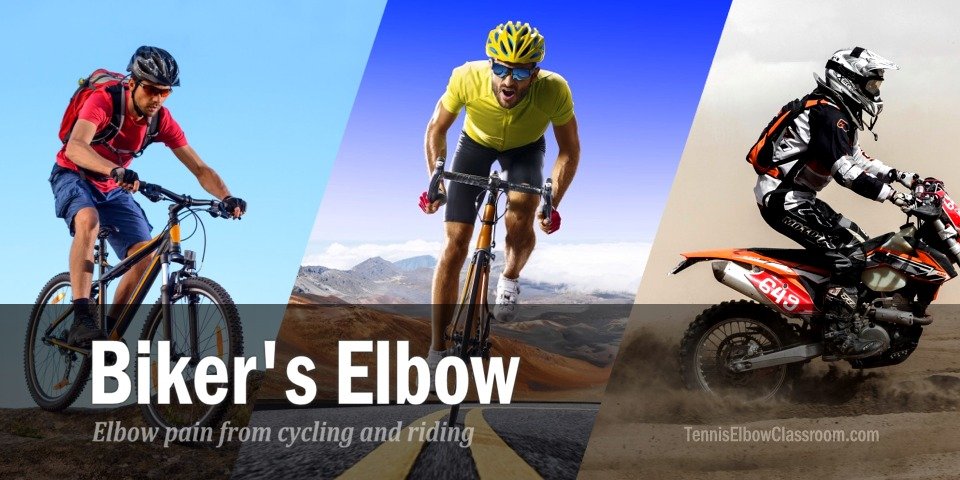
Warning Signs / Symptoms To Watch Out For
At first, all you may feel is some tension in and around your elbow.
Perhaps one or more of the following:
- Joint or tendon stiffness,
- Persistent muscle tension,
- Or significant muscle soreness
…Which may only last for a day or two after a ride – Maybe only a few hours, in the very beginning.
So, you tend to assume it’s nothing to worry about and you basically ignore it.
Gradually, though, you notice the now-familiar, tension, stiffness or soreness seems to be lasting longer and longer after your rides…
Maybe it feels like it’s “spreading to a larger area” or becoming a constant nagging ache…
Especially in the muscles in your forearm – Maybe also in the Biceps or Triceps of your upper arm.
These are the telltale symptoms, of an “Overuse” Sports Injury process starting to snowball on you.
And this is the KEY time to intervene and make some changes!
What do most riders do, though?
They slap a cold pack on it, followed by a brace… then gobble a few Ibuprofens…
And they get right back on their bikes! (Right?)
The thing is, you don’t really know any better UNLESS you’ve already been through this before. So, no one’s blaming you!
Eventually, without the right approach and treatment, however, you may find yourself experiencing:
- Burning – Even “searing” pain in your tendons – Maybe even your elbow joints!…
- It hurts just to pick up ordinary objects, like a jug of milk
- You may even feel sharp, stabbing, jolts of pain with the most basic everyday actions, like turning a doorknob or brushing your teeth!
Weeks turn into months, perhaps with a Doctor visit or two but you leave only with a brace and better pills to take, for your trouble…
Maybe you’re offered a Cortisone Shot, but watch out for that!
(There are a host of reasons why that’s a terrible idea. Follow link above.)
And once these you’ve been suffering for several months with one of these types of Overuse Injury ‘Tendinopathies’ (persistent tendon conditions) like Golfer’s or Tennis Elbow…
You can stop riding and rest all you want – “Till the cows come home” and your bike gathers a heavy layer of dust.
There’s no guarantee that that rest (alone) will help you recover at that point – absent the right treatment.
(A dirty, little secret that no one else will likely tell you.)
I call it the “Resting, Hoping And Waiting” fallacy!
(Because tendons don’t necessarily heal – JUST because you rest them!)
So, if you need better answers, keep reading – Here’s a guide to get you rolling down a faster road to recovery…
Starting with Mountain Biker’s Elbow, and tips for bike fitting and alignment, specifically for that…
(The easier, “fix it once and you’re done” tips to these riding-related injuries)…
Followed by road cyclist’s elbow (with tips, as well) then Motocross, BMX and stationary biking.
Mountain Biker’s Elbow
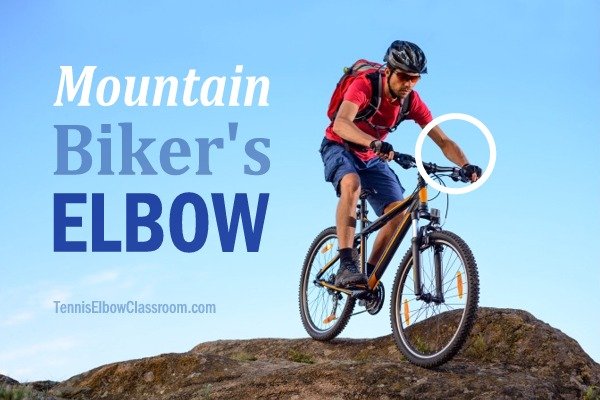
Mountain Bike riders very often suffer Golfer’s and Tennis Elbow
Mountain bikers are particularly at risk for these kinds of sports injuries.
In addition to all the things that make road riding stressful, Mountain Biking involves the rigorous aspect of steering and navigating over rough terrain…
Not to mention all the impact stresses involved in taking air and slamming into dirt and rock!
If you’re a Mountain Biker, your muscles and tendons have to work extra hard as “shock absorbers” (even if your bike has shocks!)
And you have to grip tighter just to hold on and maintain control…
All of which puts more load and stress on those busy muscles and tendons – and that can overload and eventually injure them.
(More on the dynamics of that process and what to do if you’re injured in a bit.)
The impact shock stress from riding over rough terrain can also damage joints and ligaments…
And that’s more serious than a chronic elbow tendon issue, like Golfer’s or Tennis Elbow.
Moreover, even though we’re not talking about crash injuries, like fractures and dislocations, per se…
Crash injuries DO happen more frequently in mountain biking and can be a contributing factor with these elbow conditions – especially injuries to the upper body – The shoulder in particular.
Bike Fitting Tips For Mountain Bikers
The first thing to consider as a Mountain Biker with elbow, wrist and or shoulder pain is whether your saddle is positioned correctly.
The Saddle Consideration
Is your seat at the proper height in relation to your bars?
The recommendation seems to be: “Have them at the same level when riding level terrain.”
With the exception that if you can drop it, right before you do a long bombing run, do so in order to lower your center of gravity, of course!
If your saddle is higher than your bars OR tilted forward you’ll be leaning or sliding forward (when your seat is actually in your seat!)…
Which will put more weight than necessary on your arms, invariably stressing your upper body more with every mile.
Fortunately, your saddle is the easiest thing to adjust!
Level it out, lower it – OR raise you bars – IF your saddle is already perfectly aligned with your pedals according to your leg length.
Your next consideration is probably going to involve your bars.
A fairly cheap and easy area to make adjustments (considering total bike costs.)
There are 3 major alignment-related bar factors: ‘rise’ (height) ‘width,’ and ‘sweep’ (how much the bar bends back toward the rider on either side.
Let’s talk about width and sweep…
The Bar Sweep Question
In the video below, Physical Therapist John Weirath, of Bike Fit Adviser, describes a “Handlebar Tweak To Completely Change Your Mountain Bike”
In short, with greater degrees of sweep comes a better wrist position = less ‘radial deviation’ at the wrists.
It also give you the ability to lower your elbows and shoulders and engage your lat muscles (Latissimus Dorsi Muscles) more.
Which has the added benefit of giving more stability to your lumbar spine (lower back.)
And allowing your scapula (shoulder blades) to drop down and ‘retract’ (come together) more.
The Bar Width Question
Here’s a detailed discussion focusing more on mountain bike bar width…
Including the pros and cons of both wider and narrower bars from “Global Mountain Bike Network’s” YouTube channel
“How Wide Should Your Mountain Bike Handlebars Be?”
And here’s a detailed guide to specific brands and ‘swept back’ handlebar options:
Bike Packing Guide To Swept Back Bars
There does appear to be some controversy over what the right shoulder and elbow “stance” is.
Many Mountain Bike experts and instructors are teaching an elbows out / “chicken wings” position.
Here’s a post by Lee Likes Bikes discussing this.
Lee Likes Bikes on the “In Or Out” question
And the bottom line is that “Bars determine elbow and shoulder positioning” – so choose wisely.
Road Rider’s Elbow
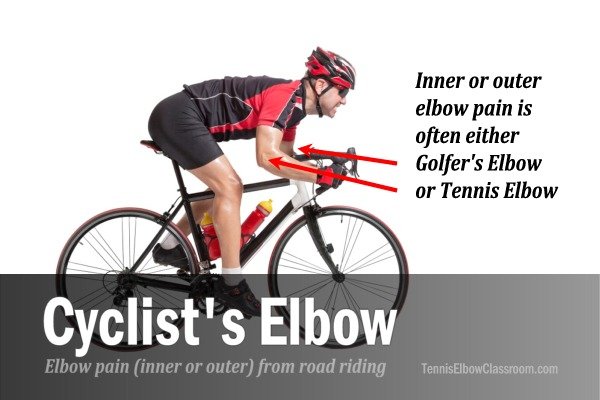
Road cyclists often suffer elbow pain and injury, which is typically Tennis or Golfer’s Elbow
If you’re a road cyclist you fortunately don’t have to contend with rough, rocky terrain (at least I hope not!)
OR the need to hold on for dear life…
However, long hours of gripping those bars and pushing out the miles still takes its toll.
And the racing position itself can be very problematic.
It’s particularly stressful on the back, shoulders, elbows and wrists.
Riding bent forward at the waist and having that much of your weight in front on your arms, is a pretty unnatural position to be in – you have to admit!
As a road rider with Tennis or Golfer’s Elbow (we’ll get to the difference shortly) you may have more work to do when it comes to proper bike fitting and alignment.
Keeping in mind that you can still develop a wrist / Elbow / hand injury over time, of course – even when your riding ergonomics ARE perfect!…
You’re certainly more likely to develop a problem and find yourself in pain a lot faster if you’re not well fitted or aligned with your bike.
Bike Fitting Tips For Cyclists
In another great video from Bike Fit Advisers below, John Weirath, describes one of the most common wrist and elbow positioning problems he sees.
“Bike Fit Tip: This Hand Position Might Change Your (Riding) Life”
It has to do with the hood placement on the bars and ones hand positioning when one is “on the hoods”
And Red Rock Bicycle advises us that:
“A well-placed hood on a drop bar gives you at least three usable hand positions; hoods, perches and drops.”
“The hoods are designed to be the place where the majority of your riding happens. From the hood you should be able to easily access the brakes and the shifters…”
“…Riders often try to compensate for a bar that is too low by rotating their bars up. This rarely solves any of their problems. By rotating the hoods up, their is no place that the hand can rest…”
The ‘Neutral Wrist Position’
Another wrist consideration when you’re riding on your perches, (and not your hoods or drops) is the question of whether you’re maintaining a ‘Neutral Wrist Position.’ (Which is neither “curled in” or extended.)
Here’s a simple, visual image showing the ideal wrist position:
Of course the same saddle tilt and “saddle height in relationship to bar height” issues apply to road riding as much if not more than in Mountain Biking:
- Is your seat at the proper height in relation to your bars? – If your saddle is higher than your bars you’ll be leaning forward and putting too much weight on your arms (Raise those bars or lower that saddle)
- Is your seat level or is it tilted forward? – If your saddle is tilted down at the nose you’ll constantly be sliding forward, which has the same effect of putting more weight on your arms and hands than necessary (Level out that seat)
Motocross Elbow Pain
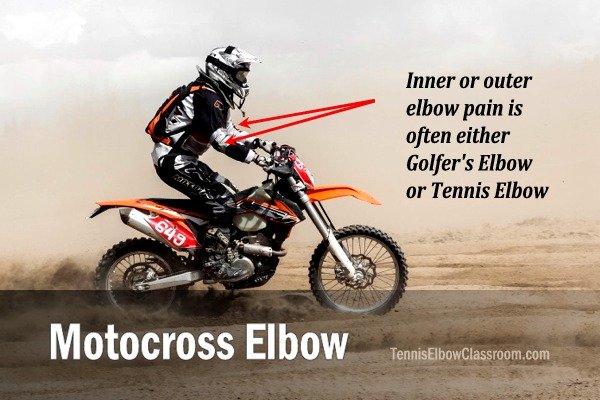
Motocross riders often suffer Tennis and Golfer’s Elbow
Motorcycle road riding and off-road dirt bike / Motocross riding are obviously very different animals.
(In a similar way to how Mountain Biking and Road Biking differ.)
Clearly Motocross is an extremely physically demanding sport.
It requires more intense gripping and the vibrations and impact stresses are much much higher than road riding.
In fact, the huge impact stresses involved in Motocross can also damage joints and ligaments…
(And these are more serious injuries than Tennis or Golfer’s Elbow!)
Here’s an article from Motocross Action Magazine about elbow injuries.
Since ‘acute’ injuries are a lot more common in Motocross than Repetitive Motion Injuries, this article deals more with those traumatic, acute types of injury:
Motocross Action Mag: Elbow Injuries [Article]
And, just like with Mountain Biking, crash injuries happen much more frequently and can be a contributing factor with these elbow conditions…
Particularly when those injuries occur to the upper body – Especially the shoulder.
You may have a shoulder dislocation or separation – Or an arm fracture that later heals – but it sets you up for a Tennis or Golfer’s Elbow injury later…
Often due, in significant part, to all the compensating that you’ll inevitably do in the wrist muscles of your forearm.
Tips For Motocross Riders
In this video, Gregg Albertson of G.A.M.E MX Training offers some tips on elbow and grip positioning.
“Elbows Up and Regripping // G.A.M.E. Motocross Techniques”
One of the key takeaways being that in order to maintain control of your dirt bike, it’s best to be in what Gregg calls an “aggressive position.”
(Which seems to be identical to Mountain Biking, except with the added need to throttle with the right wrist, which adds a lot of complexity.)
However, this aggressive, “high-elbow” position is inherently putting your shoulder into a position that’s a high risk for ‘Impingement’ – Especially on the throttle side.
Impingement Syndrome
Impingement Syndrome is a Repetitive Strain Injury that happens to the topmost Rotator Cuff tendon of the shoulder called the Supraspinatus.
It involves friction, swelling and increased pressure in a limited space, which becomes a self-perpetuating problem, since, as the pressure increases, so does the friction on the tendon, in turn causing more irritation, swelling and pressure.
The ‘Impingement Risk Position’
When the shoulder is in an ‘abducted’ and ‘internally rotated’ position, it tends to put more pressure and friction on the Supraspinatus Tendon, which can lead to Impingement Syndrome.
This becomes a greater risk the longer one spends in this position and the greater the forces involved on the shoulder.
This is a necessary evil but with any Rotator Cuff problem or injury tends to follow either Tennis or Golfer’s Elbow.
In the simplest terms, because of the compensations you get into with your hands and forearms, gripping harder to maintain stability, for example.
Sometimes this happens without any discernible injury or pain in the shoulder – simply a weak Rotator Cuff – So keep those muscles strong! See below for more on that.
And here’s a related article from Motocross Action Magazine on “bike frame geometry,” body positioning and the importance of “coiling like a snake!”
Body Position & The Art Of Bike Handling [Article]
Motorcycle Road Riding
Riding a motorcycle on the road poses similar challenges to road cycling.
The issues with gripping, squeezing the brakes and clutch and the inherent road shocks and vibrations that your muscles have to absorb.
And the alignment issues with your bike, depending whether you ride a more upright “Harley” kind of bike or a racing-type bike.
Here’s a resource if you’re actually in the market for a bike and want to make sure it’s a good fit for your body:
This article describes a tool call the Motorcycle Ergonomics Simulator
And you’ll find the link to the actual site with the tool there (and very little explanation)
BMX Related Elbow Pain
BMX riding unfortunately has many of the same risk factors as Mountain Biking and Motocross.
It may not involve as much vibration but the impact stresses that are involved (with jumps and tricks) are very harsh.
(Which also risks damage to joints and ligaments.)
That, along with the need to be gripping hard much of the time to stay in control, puts BMX riders at a significant for elbow injuries.
Stationary Bike Riding / Spinning
Stationary biking at home or in Spin Class at the gym fortunately doesn’t have the impact stresses or vibrations involved in other forms of cycling…
So, there’s a much lower risk of more serious ligament and joint injuries.
However, all the gripping while bent forward can still add up.
If you’re wondering if you could have Tennis or Golfer’s Elbow from spinning or riding your stationary bike at home, the answer is:
Yes, it’s possible.
One of the unusual, and seldom-discussed issues with cycling (whether on a road or stationary bicycle) is the compensation factor.
You may be (unconsciously and inadvertently, of course) compensating for a weak hip or shoulder by tensing or pulling on one hand grip or the other.
With so many repetitions and with muscle fatigue setting in after many long minutes on the bike your weaker non-dominant hip and leg could be recruiting a little help from your upper body.
A tiny, unobtrusive little tensing of the opposite shoulder, elbow and wrist – over and over…
Can build a pattern of tension that eventually over-stresses your wrist muscles in your forearm, leading to Tennis or Golfer’s Elbow.
Tension, Posture And Alignment Causes (ALL Bikes)
Apart from all the position / ergo-related causes of wrist and elbow pain in cyclists, there are other factors having to do with tension and vibration.
In the simplest sense, it comes down to gripping / “over gripping” and the amount of vibration and impact stress you’re absorbing.
This is a big issue in many sports where you have to hold a racket, club or bar of some kind, including tennis, golf, weight lifting…
Especially if it involves vibration or impact stress, like with tennis, golf and cycling.
Why is all this gripping of the handle bars and the squeezing of the brakes an issue for some cyclist and not others?
That IS the $60,000 question!
It’s so frustrating when you’re the one who’s injured and limiting your riding while everyone around you seems to be riding constantly without issue!
But try not to dwell on that if you can help it!
Instead, ask yourself these 4 questions:
1. Are You ‘OVER Gripping’ Your Bars?
There is nothing to be gained by death gripping your bars (or your racket or clubs, if you happen to play tennis or golf, too)
There is only wasted energy and excessive tension being generated that’s constantly feeding into the tendons involved and leading to injury.
2. Cyclists: Are You Locking Out Your Elbows?
There is a time and a place for locking out your elbows, which means to fully ‘extend’ or straighten them.
A prime example would be when doing a handstand…
However! When you’re riding a bike (particularly a road bike)…
You want to allow at least a slight bend in your elbows.
Even if only a few degrees of bend.
This allows your muscles to actively “cushion” some of the shock and adjust to the load you’re placing on your upper body through your wrists, elbows and shoulders…
Otherwise, a lot more of the vibration and shock will tend to be absorbed directly by the joints of your elbow (Yes! There is more than 1 joint in your elbow.)
(This is not really an issue for Motocross and Mountain Bikers, since, as a rule, they have to maintain a lot of bend in the elbows to stay in control.)
3. Are You Maintaining “Neutral” Wrist Alignment?
A ‘Neutral’ wrist means that your wrists are more or less straight and neither flexed or extended.
Excessive Wrist Extension is very common in non-motorized biking AND on the throttle side among road and Motocross riders.
When your wrists are extended your Wrist Extensor Muscles are in a shortened position.
This isn’t a big deal for short periods of time but constantly being in this position may contribute to Tennis or Golfer’s Elbow.
4. Do You Really Have Enough Upper Body Strength?
Too much emphasis is given to lower body strength in cycling and the upper body is often neglected.
(Perhaps not motocross or BMX – We’re talking about self-propelled and stationary bikes at the moment)
It’s not just about having the strength in ones forearms and hands to hold, grip and squeeze…
It’s also essential to have adequate shoulder strength.
Especially in the Rotator Cuff – to counter balance the powerful lateral (side-to-side) forces generated by the lower body while pedaling.
This is an expansive topic that could fill pages but, in short, consider doing some upper-body weight training of your major muscle groups.
Some areas for exploration:
Basic, major muscle groups: Biceps, Triceps, Deltoids and “Lats” – (They’re all working when you cycle, just not as much as your calves, quads, hamstrings, glutes and other hip muscles)
The Rotator Cuff: These muscles are the primary stabilizers of the shoulder joint – (Lack of strength and stability here often manifests in mysterious shoulder and upper arm pain – as well as compensations in the forearm, which contribute greatly to Tennis and Golfer’s Elbow!)
Wrist and Finger Flexors and Extensors: These are the muscles involved in gripping and squeezing – (The ‘Static’ holding / gripping necessary for riding can excessively fatigue them – Resistance exercises to strengthen them, a little at a time strategically, can go a long way to overcoming that tendency!)
How Does Cycling Cause Tennis Or Golfer’s Elbow?
Elbow and wrist pain injuries among all types of cyclists and bikers are often the result of the poor bike fitting, and alignment issues we’ve just covered – at least in part!
These are the “easy fixes.”
And what remains is the inherent tendency to develop patterns of muscle tension, fatigue and compensation.
This is often the greater challenge.
In other words, once you’ve optimized your bike fit, alignment and posture there will still be largely unavoidable tension-producing patterns, which are simply the nature of riding a bike.
(You have to squeeze to brake, you always need to be holding on – and sometimes you have to hold on really tight!)
How these patterns of tension end up causing injury and pain is a simple matter in some ways – and complex in others…
Simple, in that:
- Overloaded muscles become tense, weak muscles,
- Tense, weak muscles will feel achy, sore and painful – in protest,
- Persistent, ‘chronic’ muscle tension eventually overloads the tendon,
- And the tendon begins to break down – often increasingly painfully.
Now, the exact process of how this causes the tendon to be injured is still not fully understood, though, surprisingly.
(This is where things get more complicated.)
The key to beginning to understand what IS well-known about these injuries, however, is that the process is usually a chronic, ‘degenerative’ one…
Always keep in mind that this is a continuum with stages of severity…
A gradual, insidious process that creeps up on you (at least, at first)
A process that can start, stall, progress, heal and reverse and then get worse again.
NOT an all-at-once, acute (sudden trauma) injury – like a sprain or other type of tear.
(Although, eventually, tears can sometimes happen to tendons that have been significantly weakened by this degenerative process – IF it progresses unchecked long enough.)
So, the key thing to grasp right away, is that these tendon injuries, whether “Tennis” “Golfer’s” or “Cyclist’s / Bikers” Elbow…
Are usually of a gradual, degenerative nature, which is called ‘Tendinosis’
NOT an acute condition called ‘Tendonitis’ – Which would be an inflammatory condition.
Especially once they become chronic, (which is just a technical term for stubbornly persistent.)
This is where tendon injury sufferers of all kinds are often led astray and go wrong.
The myth that these injuries are inflammatory “TendonITIS” is extremely persistent in both medical circles and layman’s lore.
Now, of course, if you heed the early -warning signs and quickly correct your bike fitting and alignment issues…
And you start a program to strengthen the right upper body muscles…
You may avert an injury – or reverse it in its earliest stage.
But once it becomes a full-blown injury, you may have a bit more work to do.
So, let’s get into the right and wrong ways to treat these frustrating, disruptive injuries, once they become chronic (persistent.)
The Wrong Way To Treat These Injuries
If your injury is relatively new and you’ve never had a tendon injury like this before you may be unfamiliar with the Standard Treatments.
If you’ve been down this road before, or you’ve been on it awhile already you may be familiar with these “treatments:”
Anti-inflammatories in pill form – Both prescription and over-the-counter. To “reduce” inflammation (which act systemically on your whole body, since taken internally.) More on the inflammation story
Lotions, creams and other topical remedies – To “reduce” inflammation or simply relieve symptoms. (At least they are more “locally” applied and not taken internally.) More about topical remedies here
Icing / cold packs / Cryotherapy – Can be used to simply relieve pain but you’ll be told to do it to “reduce inflammation.” Read more about icing
Cortisone Shots – A very powerful way of suppressing pain and inflammation locally in and around the injured tendon (and quite dangerous if you what you want most is long-term healing) Here’s the full story on Cortisone Shots
Braces and other supports – These seem intuitively like a good idea: Injury? Protect it by limiting motion! Right? (The problem is, sprains and fractures aside, mild to moderately injured tendons do not heal better when immobilized. They need movement to heal properly.) Read more about why braces are not the right approach
Apart from braces, most of the standard medical and “common wisdom” treatments, including others not listed above, are misdirected at chasing and trying to suppress inflammation.
And the short answer to why this is utter madness is because:
Inflammation is an essential part of the healing process.
Which naturally raises the question of:
“How could a stage of the healing process itself be a cause of the injury – or even a problem?”
You can’t heal a ‘Soft Tissue’ injury (damage to muscle, tendon, ligament etc.) without an inflammatory process.
This is one of the most commonly learned and promptly forgotten facts learned in medical and nursing schools!
(And in Acupuncture / Chinese Medicine schools / programs, perhaps?)
The Right Way To Treat These Injuries
So, what’s the right approach to healing a tendon injury like Golfer’s or Tennis Elbow? (Or Cyclist’s Elbow, if you like)
You can probably already guess that it doesn’t involve attacking and trying to suppress inflammation, at this point, right?
We mobilize our muscles and tendons with specific hands-on techniques, and gentle stretches (instead of immobilizing them with a brace.)
See this article and video on the key role of Advanced Self-Massage Techniques
We warm the area regularly to stimulate circulation and the healing that comes with good blood flow (refraining from freezing our muscles and tendons with ice, which inhibits circulation)
We allow inflammation to do what it needs to do, which is to kick off the healing process (rather than relentlessly trying to suppress it through pills, shots and ice)
And we delay rehab exercises – Yes, strengthening exercises are essential at the right time, (but the problem, in my experience, is that they’re often begun too early)
We postpone rehab exercise until we first make some progress healing and the worst symptoms have subsided…
Here’s more on The Three Key Principles Of Rehab Exercise
And here’s more on the overall Tennis Elbow Classroom Treatment Strategy
AND if you need some help putting together a self-help plan, you’re certainly in the right place!
Just follow one of the links below, depending on whether you have Tennis or Golfer’s Elbow:
Learn To Treat And Heal Your Own Tennis Elbow Or Golfer’s Elbow At Home With This Video Program
You’ll get instant access to a complete VIDEO program designed by a professional therapist to help you take charge and break your vicious cycle of pain and frustration!…I’ll be your personal tutor guiding you through step-by-step video lessons, where you’ll get the therapy techniques, key stretches and essential exercises you need to treat and recover from your injury at home. (Without any special equipment.)
Tennis Elbow sufferers: Learn more about the home program here
Golfer’s Elbow sufferers: Learn more about the home program here
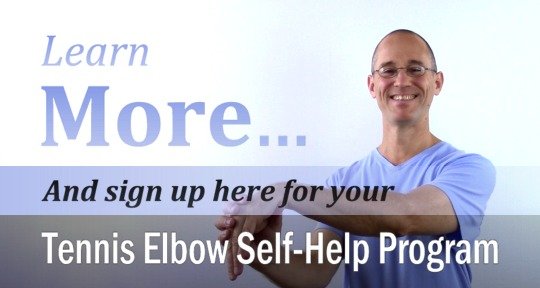






I just listened intently to your tome of what, why, when blah blah etc regarding injuries. I would have subscribed, however, thinking that you were offering a free service and so I listened and waited for the actual secrets, I relied that there is a cost. So, I’m not subscribing. The reason is that your video presentation was deceptive. If you’d told me right from the beginning that this was a $ subscription service, I would not have wasted any of my time, wrongly thinking that you had a cure for me. You people are all the fkn same, leading people on with your rambling verbiage but eventually, some of us get suspicious, but I’m guessing that your devious mind is already geared up for that. You’re not even worth a ‘goodbye’
Helpful.
Thanks!